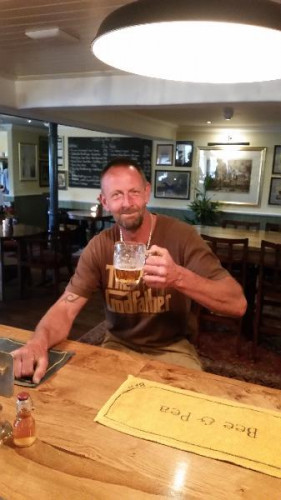Our forebears from many hundreds of years ago were every bit as entrepreneurial as we might consider ourselves, and the deep history of the Falcon demonstrates clearly how many of our current businesses were seeded way back in the roots of time and still bear fruit today.
The Falcon was built in 1770, five miles north of Banbury and on the road to Warwick. It was built there to specifically take advantage of the busy turnpike road that led to the expanding centre of commerce that was Birmingham, and faced the tiny Toll House cottage, where travellers would have to stop to pay their levy for their on-going journey.
The road, now the B4100, was turnpiked under an Act of Parliament of 1727 which permitted a private company of trustees to take over the roads from Birmingham to Warmington via Warwick (and the Birmingham to Edgehill road via Stratford-upon-Avon) and to exact tolls for road maintenance and improvement. These roads lay wholly within the county of Warwickshire
and it was a few years before the next section of the road from
Warmington to the south through Banbury was also turnpiked. It was
the manufacturers of the Birmingham region who badly wanted the road
improved for conveying their products.
The gradient on Warmington Hill has been improved on several occasions, but was quite precipitous in those early days. It is likely extra horses would have been needed to help heavy loads up the hill and the pub would be the obvious place to unhitch them before they were returned downhill.
What better place to take advantage of passing trade horses could be fed and watered, and re-shoed if necessary, coaches could be repaired , and the travellers themselves would be in need of sustenance, a pleasant rest from the toils of travel, and perhaps a bed for the night.
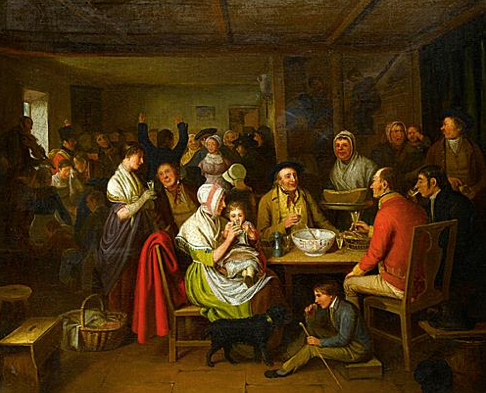
One of Alexander Carse's 17th century works, 'Revellers in an Inn', depicts a happy group consisting of local men, women, children and some finely dressed soldiers, with a family as the central tableau in the foreground. Whilst they eat and drink (even the child is being helped to a glass of punch from the shared bowl) a band plays in the background, and the patrons of the inn raise their arms and dance.
Much like now, in fact.
What is now the Falcon was at one time called called the Hare and Hounds, then became the Hare and Dog - the hunting of hares was a popular sport. The stone and thatch property was built by a local carpenter named Samuel Taylor, who had already built several cottages and converted various buildings to residential use within Warmington.
The square plat of land, measuring one rod and one perch (about a quarter of a acre) , had been granted to a local man, Thomas Parish, in lieu of the right to graze two sheep on the common lands when the fields surrounding the village were enclosed, Previously, it had been very rare to be able to build outside the curtilage of the village, but in this manner Thomas was able to take advantage of the opportunities the turnpike afforded.
Thomas Parish, a childless widower, died in 1798, and the property passed to his nephew William Parish, a woolcomber from Northamptonshire, who duely sold it on to a local farmer, James Jobson, for £18 and 18 shillings. He himself sold the land on to the aforementioned carpenter Samuel Taylor who had actually previously built the property.
Samuel Taylor owned the property for nine or ten years before he sold it to a local publican, Thomas Wilkins of Warmington.
Thomas Wilkins already owned a pub in the village, called the Hare and Hounds, and it was during his time as landlord of the two pubs that he transferred the name the 'Hare and Hounds' from the pub in the middle of the village to the pub on the main road opposite the Toll house. The pub in the village then was re-named the Plough.
The new Hare and Hounds was known by that moniker for some 150 years, and was subsequently re-named The Wobbly Wheel in 1970: about this time it lost its thatched roof as a result of a fire.
Presumably the pub had become so-named in recognition of the 19th century Wyatt family, who had a long association with the pub as tenant landlords, while continuing to operate their trade as wheelwrights servicing the carriages using the toll road, as well as local agricultural and domestic transport. William Wyatt held the licence from 1816 until his death in 1856, and was succeeded for many years by his son of the same name.
The Wobbly Wheel operated under the auspices of the Spirit Group, then became a 'Brewer's Fayre' under Whitbread, who built a 54 bedroom hotel to the rear of the pub.
But then, on the afternoon of Thursday 5th September 2013, a fire started in the roof space of the hotel, which was consumed by flames. Thankfully, all were evacuated and no-one was injured, though the hotel was eventually pulled down.
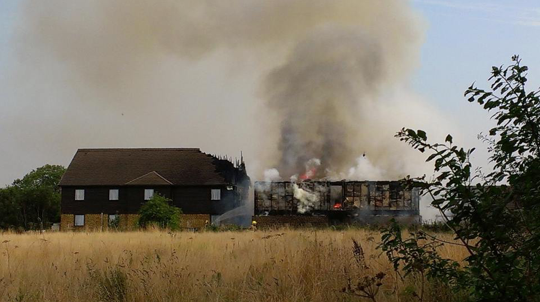
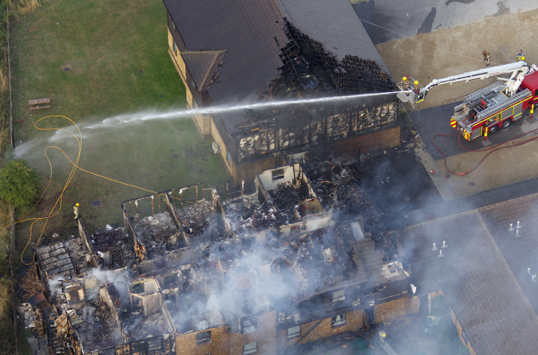
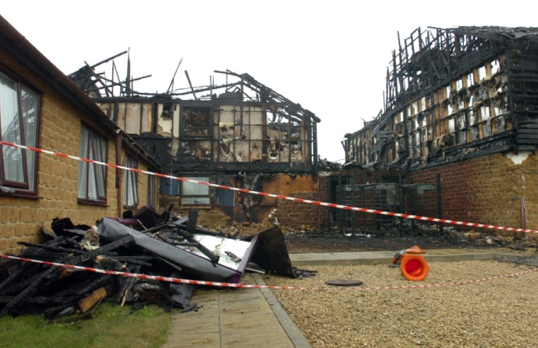
We bought the property in 2015 and renamed it the Falcon, to signal the major change in operation.
Publicans
- Thomas WILKINS had become the licensee of the pub in Warmington village in 1807. It was called The Plough.
- The Hare and Hounds was operating as a tavern in 1847, run by William Wyatt who was a farmer, wheelwright and publican. It was in a track-side location so a wheel wright would have been in demand. When William Wyatt was publican the pub was called the Hare and Hounds. He was still there in 1850.
- In 1866, COLEMAN Thomas is listed against 'Hare and Hounds.'
- In the National Archives, there are deeds relating to the Hare and Hounds (also known as the Hare and Dog), together with nine acres purchased by the Reverend Charles William Holbech from John Alfred Stranks for £1,000.
- In a trade directory of 1869, John Tasker was the Victualler of the Hare and Hounds, and the Wyatt family were still listed as wheelwrights. He was still there in 1874.
- In 1883 a RN Mace is listed as "Hare and Hounds".
- In 1928, Taylor William is at the Hare and Hounds public house.
(from electoral registers): William TAYLOR (in 1920), Frederick Henry BENNETT (in 1939)
Particular thanks to Liz Newman, local historian, for her invaluable help in compiling this article and sharing her hard-won knowledge so freely.
If you wish to know more about Warmington, there is an excellent website here, which has informed much of this article:
http://www.warmingtonheritage.com













